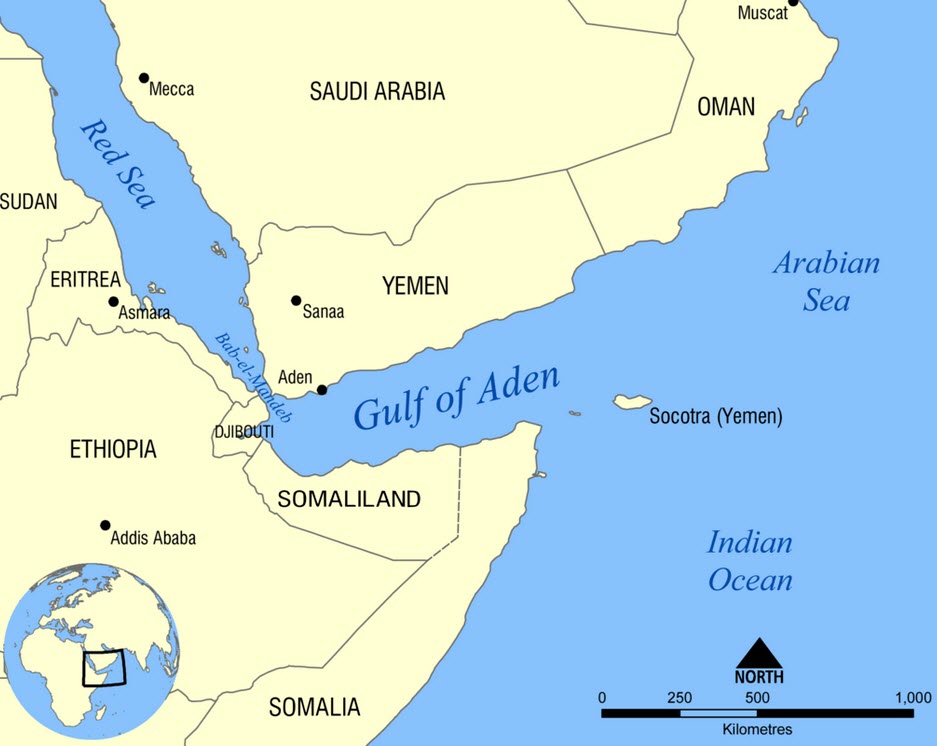Contents
The Gulf of Aden, a narrow body of water between the Horn of Africa and the southern Arabian Peninsula, is a critical juncture in the world’s maritime routes. This vital waterway, linking the Indian Ocean with the Red Sea and onwards to the Mediterranean via the Suez Canal, is a pivotal route for global trade and a region of significant geopolitical interest and environmental diversity.

Geography and economy
The Gulf of Aden is a deepwater gulf in the Indian Ocean, in the strategically important region between the Horn of Africa and the southern Arabian Peninsula. It borders Yemen, the Arabian Sea, Djibouti, the Guardafui Channel, Socotra, and Somalia. It connects with the Red Sea through the Bab-el-Mandeb Strait in the northwest.
Spanning approximately 1,000 kilometers (about 620 miles) in length and 150 to 440 kilometers (about 93 to 273 miles) in width, the Gulf of Aden is of heavy strategic importance. It acts as a maritime corridor for vessels travelling to and from Europe, Asia, and the Middle East, carrying a significant portion of the world’s seaborne oil shipments and commercial goods.
Historically, the Gulf of Aden has been a crossroads of civilizations, with ancient trade routes passing through the region for centuries. It has facilitated trade and cultural exchanges between the Mediterranean, Arabian Peninsula, and Indian subcontinent.
In modern times, its economic significance is underscored by the volume of global trade that passes through, including oil from the Persian Gulf region, making it one of the busiest shipping lanes in the world. As the Gulf of Aden is important for the shipping of Persian Gulf oil, it is important for the world economy.
Examples of notable economic hubs along the Gulf of Aden are Djibouti City, Berbera and Bosaso on the African side, and Aden in Yemen. They are all important ports, alongside other ports such as Balhaf, Bir Ali, Mukalla, Shokra, and Zeila.
Trivia! The Aden Ridge is situated in the middle of the Gulf of Aden, and tectonic forces are causing the gulf to widen by roughly 15 mm per year.
Environmental and ecological aspects
The temperature of the Gulf of Aden typically stays in the 15 °C – 28 °C range and is impacted by the monsoons. The salinity is at its highest in the gulf’s centre, where it is 37.3 ‰ at a dept of 10 metres.
The Gulf of Aden is home to diverse marine life and ecosystems, contributing to its ecological importance. The gulf’s waters are critical habitats for various species of fish, marine mammals, and birds. The unique environmental conditions, including the seasonal monsoon winds, influence the productivity of the region’s marine ecosystems and impact both local fisheries and international biodiversity conservation efforts.
Fishing is typically carried out from small and fairly isolated fishing towns and villages along the coast, and local fishermen do not venture far away from the coast during normal circumstances. Sardines, tuna, kingfish, and mackerel are important food fishes, but the water is rich in not just fish but also in lobsters and crayfish.
Exclusive economic zones
Exclusive economic zones in the Gulf of Aden:
- Somalia, 831,059 sq km
- Yemen, 509,240 sq km
- Djibouti, 7,037 sq km
Security challenges
The strategic significance of the Gulf of Aden has made it a hotspot for maritime security concerns, including piracy and the risk of terrorism. The early 21st century saw a surge in pirate attacks off the coast of Somalia, threatening international shipping and prompting a coordinated international naval response to protect vessels traversing the region. Efforts to improve maritime security have seen some success, but the gulf remains a focus of international efforts to combat piracy and ensure maritime traffic safety.
International cooperation
The importance of the Gulf of Aden has led to significant international cooperation, both in terms of security and environmental protection. Naval patrols by multinational forces have been established to deter piracy and ensure safe passage for commercial ships. International agreements and collaborations also aim to address environmental concerns, such as overfishing and pollution, to preserve the Gulf’s marine biodiversity.
Conclusion
The Gulf of Aden stands as a testament to the complex interplay between geography, economy, and geopolitics. Its waters are not only pathways for global commerce but also arenas for international diplomacy, security challenges, and environmental stewardship. As the world continues to navigate the intricate dynamics of global trade and regional stability, the Gulf of Aden will undoubtedly remain a focal point of strategic importance on the world stage.